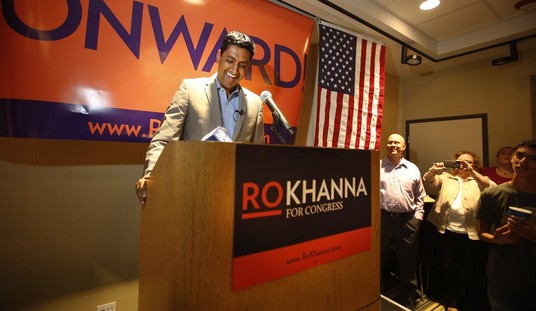In last night’s debate, the term “middle class” only got eight mentions: two by Mitt Romney (the first and the last), and six by Barack Obama. Given all the rhetoric that Team Obama has floated in this cycle about middle-class concerns and how out of touch Romney is with them, one would have expected Obama to hammer on this theme — especially in a debate that focused on domestic policy. Yet Obama barely mentioned it, perhaps to avoid having to answer for his running mate’s jaw-dropping gaffe from earlier this week:
After last night’s debate, some suggested that Obama would have to rely on Joe Biden to rescue him in the next scheduled debate, the Vice Presidential square-off on October 11th with the well-prepared Paul Ryan. Any strategy that relies on Joe Biden to win an intellectual exercise is already doomed to failure, as this clip amply demonstrates. But was this really a “gaffe”? In my column today for The Fiscal Times, I argue that it’s only a gaffe in the Kinsleyan sense — and that Biden is right that the middle class has been buried, but under an avalanche of bad Democratic policy:
Perhaps Biden missed a memo or two, but for most of the last four years, his running mate, Barack Obama, has been President. For two of the last four years, his party controlled Congress by large majorities, as well as the two years that preceded those, and Biden’s party has controlled the Senator for all six years. In fact, both Biden and Obama sat in the Senate previously, Obama for four and Biden for decades. If the middle class has been buried, it’s been on their watch.
Is this a political inconvenient truth? Has the middle class been “buried” the last four years? By any measure, the middle class has certainly lost ground. Median household income has declined each of the last four years, a decline which has accelerated during the Obama “recovery” that started in June 2009. Median household income dropped 2.6 percent during the Great Recession, but has dropped 4.8 percent in the three years since.
That is one reason why the Census Bureau reported three weeks ago that the middle class had declined to“an all-time low” in 2011, as the Washington Post headlined their article on the subject. By the third year of Barack Obama’s presidency, poverty had leveled off at a near all-time high as well, while the middle class continued to lose ground on income. But that wasn’t the only measure on which the middle class found itself moving backward; their average work hours also declined, as did the average pay rate, while home values continued to decline. The percentage of Americans with jobs fell to a 31-year low in August at 63.5 percent, another symptom of a decline in the middle class.
All of this occurred during the Obama/Biden administration, a point that the Democrats had tried to avoid during the 2012 campaign. Biden’s admission that the middle class has been “buried” will certainly resonate with voters who have experienced the decline first hand. It will also force the media to give some attention to that decline, writes Jennifer Rubin at the Washington Post. “On the Biden remark, the media sure seemed miffed to have to respond to the Romney campaign,” Rubin notes, and “that was the reason, of course, the Romney-Ryan ticket pounced on Biden.… At least they got the media to report that the middle class has lost ground under Obama.”
On the plus side, I argue that this means the Obama administration finally delivered on one particular promise:
Biden’s right about the middle class being buried. But it’s his own administration and party that did the burying, which has been the only shovel-ready job the Obama White House managed to produce.
With Team Obama backpedaling on the middle class, Romney stays on offense today with a new 30-second TV spot. In “12 Million Jobs,” Romney promises to lift the middle class out of their decline by creating the jobs necessary for wage growth:
http://www.youtube.com/watch?feature=player_embedded&v=BsHoWjzicUA
Romney puts energy production reform first — a big key that last night’s exchange on green-tech subsidies will help emphasize. We cannot grow the economy while making energy more expensive. We have to find ways to make energy cheaper now, and that means putting a real “all of the above” energy policy in place. After last night’s debate, Romney will almost certainly have a lot more people listening.
Update: As if to underscore the point, overall orders for manufactured products dropped by 5.2% in August:
New orders for manufactured goods in August, down two of the last three months, decreased $24.9 billion or
5.2 percent to $452.8 billion, the U.S. Census Bureau reported today. This followed a 2.6 percent July increase. Excluding transportation, new orders increased 0.7 percent. Shipments, down two of the last three months, decreased $1.3 billion or 0.3 percent to $476.9 billion. This followed a 1.9 percent July increase. Unfilled orders, down following two consecutive monthly increases, decreased $17.0 billion or 1.7 percent to $978.8 billion. This followed a 0.7 percent July increase. The unfilled orders-to-shipments ratio was 6.27, up from 6.23 in July. Inventories, up two consecutive months, increased $3.7 billion or 0.6 percent to $611.8 billion. This was at the highest level since the series was first published on a NAICS basis in 1992 and followed a 0.6 percent July increase. The inventories-to-shipments ratio was 1.28, up from 1.27 in July.
Reuters looks for the silver lining:
Demand for U.S. factory goods in August fell by the most since January 2009, but the second straight month of gains in orders outside transportation hinted at a less rapid loss of momentum in manufacturing activity.
The Commerce Department said new orders for manufactured goods tumbled 5.2 percent — the biggest drop since the recession — dragged down by a slump in demand for transportation equipment that was telegraphed in last week’s report on orders for long-lasting manufactured goods.
Factory orders had risen 2.8 percent in July and economists had expected them to drop 5.8 percent in August. Excluding transportation, orders rose 0.7 percent in August after rising by the same margin the prior month.
Not that there isn’t a “loss of momentum” in manufacturing, but it’s less rapid than the topline indicates. That’s a pretty slender reed, especially for the middle class that depends on a healthy manufacturing sector,







Join the conversation as a VIP Member